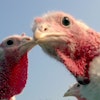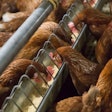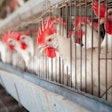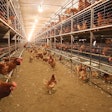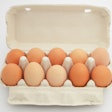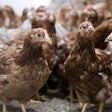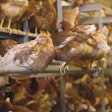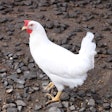
2024 is the equivalent of “the witching hour” for U.S. egg producers in the industry’s shift toward cage-free egg production, but decisions made regarding cage-free investments aren’t the only thing that promise to make 2024 interesting.
1. Lower feed costs
The December 2023 WASDE report projects average farm price for a bushel of corn in the 2023-24 crop year will be US$4.85, a US$1.69 (26%) drop from the estimate for the 2022-23 crop year. The average price for a ton of soybean meal is projected at US$390 per ton, down US$62 (14%) from the estimate for the 2022-23 crop year. If these projections are correct, this will mean that an average layer ration would be approximately US$54 per ton less expensive in the 2023-24 crop year than in 2022-23, and feed cost per dozen eggs would drop by approximately 8 cents.
2. HPAI pandemic
The number of U.S. layer flocks and the total number of head lost to highly pathogenic avian influenza (HPAI) in 2023 through December 8 was dramatically lower than in 2022 (Figure 1). HPAI is still endemic in wild bird populations in Europe and Asia as well as in North and South America, and it represents a significant risk for egg producers. Biosecurity programs need to continue to be followed and all procedures need to be monitored and reinforced. Farms located near bodies of water are at particular risk. Structural biosecurity measures and proximity to bodies of water need to be considered as critical components when selecting sites for new pullet and layer farms.
3. Industry consolidation
Several U.S. layer operations were acquired by other egg producers in 2023. Cal-Maine Foods acquired Fassio Egg Farms Inc., Daybreak Foods acquired Hen Haven LLC and Schipper Eggs LLC, MPS Egg Farms acquired Country Charm Eggs, and Kreider Farms acquired Esbenshade Farms. It is expected that this trend of increased acquisitions will continue. The capital investment required to replace or convert existing cage housing to cage free is driving some egg producers to sell rather than double down on their investment.
The U.S. table egg industry is not considered to be concentrated now, nor has it ever been. The U.S. Justice Department and the Federal Trade Commission use the Herfindahl–Hirschman Index (HHI) to measure the level of concentration in an industry. The HHI is calculated by squaring the market share of each firm competing in the market and then summing the resulting numbers. The HHI factors in the relative size distribution of the firms in a market. It approaches zero when a market is occupied by many firms of relatively equal size and reaches its maximum of 10,000 points when a market is controlled by a single firm. The HHI increases as the number of firms in the market decreases and as the disparity in size between those firms increases.
According to the U.S. Department of Justice's website, “The agencies generally consider markets in which the HHI is between 1,500 and 2,500 points to be moderately concentrated and consider markets in which the HHI is in excess of 2,500 points to be highly concentrated.”
Egg Industry has calculated the HHI for the U.S. layer industry using the Top Egg Company Survey number of hens housed on December 31, 2023, for U.S. egg producers. The HHI based on this year’s survey numbers is 446, it was 437 based on the number of layers housed on December 31, 2022.
WATT PoultryUSA conducts annual Top Broiler Company and Top Turkey Company Surveys. For comparison, the 2022 HHI calculations for the U.S. broiler (based on average weekly ready-to-cook pounds produced) and turkey industries (based on annual liveweight slaughtered) were 1,082 and 930, respectively.
4. Cage-free egg sales
Most cage-free egg purchase pledges will be coming due in 2025. Many expect food service outlets to fulfill purchase pledges assuming enough cage-free eggs are available. Most U.S. consumers still purchase less expensive cage-produced eggs when shopping at retail stores. Kroger and Walmart have backtracked on their original cage-free egg purchase pledges. How many retail chains will choose to only stock cage-free eggs when competitors are selling eggs from cage-housed hens at substantially lower prices? Egg producers will need to keep up with their retail customers’ plans for 2025.
As you read this, because of legislation, egg sales are 100% cage free in California, Massachusetts, Nevada, Oregon and Washington state. The human population of these five states represent approximately 18% of the U.S. total. Michigan and Utah will shift to 100% cage-free egg sales in 2025, and Rhode Island’s switch will be in 2026. By the end of 2026, approximately 22% of the U.S. population will live in states where all eggs sold must come from cage-free hens.
I think 2024 will be a challenging year for U.S. egg producers, possibly for some reason outside the four I have explained above. I hope retailer, food service and food processing companies purchasing eggs notify their egg suppliers well in advance regarding their intentions. I also hope these companies factor what they have learned from this process from future purchase pledge to execution for cage-free eggs into any other decisions they are considering regarding purchases of products from animal agriculture.


